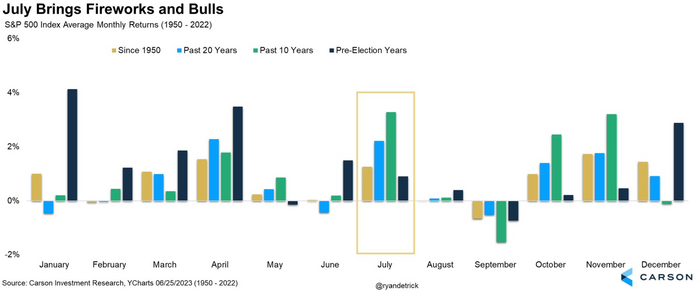July ranks as a top month for the S&P 500 over the past 10 years, with a 3.3% average gain, according to the Carson Group

Conventional investing wisdom dictates that the summer months are a sleepy time for markets. But that has started to change over the past decade.
July has actually been the best month for U.S. stock performance during this period, with the S&P 500 index rising 3.3% on average between 2012 and 2022, according to an analysis from Carson Group. That is an improvement over the average July performance since 1950, which saw the index gaining 1.3% on average.

Last July was a notable example, with the S&P 500 advancing more than 9%, according to FactSet data, as the market rallied off its June lows on expectations that the Federal Reserve might pivot back to cutting rates.
While hoped-for Fed rate cuts never materialized, U.S. stocks have continued to climb in 2023. To be sure, much of the rally has been driven by megacap technology stocks, including those of Nvidia Corp. and Microsoft Corp.. But the S&P 500 has risen 14% date in 2023, according to FactSet data, an impressive rebound after stocks last year logged their biggest pullback since 2008.
To be sure, there have been signs that the rally has started to broaden recently, with small caps in the Russell 2000 index and other unloved sectors of the market advancing over the past month.
But a big question is whether markets can continue to thrive this summer. Carson Group’s Ryan Detrick expects they will, even though he has been bullish on stocks since the S&P 500 hit its most recent 52-week low back on Oct. 12, according to FactSet data.
Detrick pointed out that the last few summers have seen some searing rallies. July also has been an important counterpoint to the typically sleepy summer months. He also said he thinks that, as long as the U.S. economy avoids a recession, stocks should move higher.
“We’re optimistic with a continued improving economy that this rally might have legs still,” Detrick said in a phone interview with MarketWatch.
Detrick cited the latest batch of official U.S. data released Tuesday as evidence that the U.S. economy remains healthy, as a key gauge of consumer confidence rose to its highest level in 17 months. Meanwhile, orders for manufactured U.S. goods jumped 1.7% in May and rose for the third month in a row, data show.
If he had to guess at why July has been such a boon for stock valuations lately, Detrick said corporate earnings have likely been a major factor. Typically, the largest U.S. companies will report their corporate earnings for the second quarter before the end of July.
Historically, S&P 500 companies’ reported earnings overshoot Wall Street expectations, according to FactSet’s John Butters, the company’s senior earnings analyst. However, there have been some signs of trouble heading into earnings season. Analysts have lowered earnings estimates for S&P 500 companies for the second quarter, as the bottom-up earnings-per-share estimate for the S&P 500 has fallen 2.3%, since March 31.
Other analysts have noted that equity valuations are again beginning to look stretched. Richard Farr, chief market strategist at Merion Capital, pointed to the S&P 500’s price-to-earnings ratio.
According to FactSet, the price-to-earnings ratio for the S&P 500 for the coming 12 months has risen to 18.8, which is above both the five-year average of 18.6 and the 10-year average of 17.4.
Farr is also worried about what might happen to stocks if the tide of liquidity emanating from the Federal Reserve and the banking system were to ebb. “There is still too much money in the system, and the Fed knows it. It is all about liquidity,” he said.
U.S. stocks mixed on Tuesday, with the S&P 500 rising 1.2%, lifting it by 14% for the year, while the Nasdaq Composite gained 1.7% Tuesday and 29.5% in 2023. The lagging Dow Jones Industrial Average advanced 0.6% Tuesday and 2.4% on the year.
